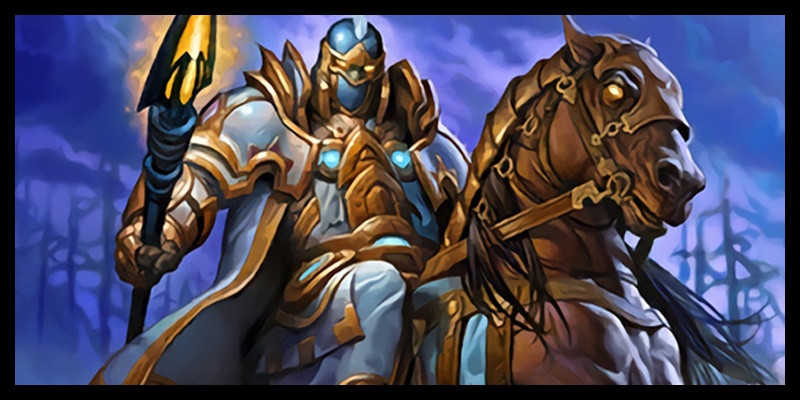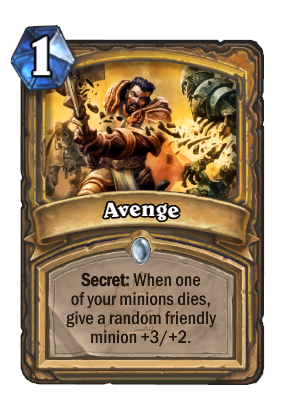The early votes are now in for most hated card of The Grand Tournament, and the lucky winner is: Mysterious Challenger.
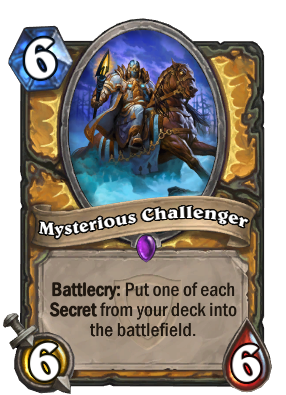
Once upon a time, nobody played secrets in constructed, because spending mana to do nothing (but maybe have something happen later) is bad. Blizzard, understandably, wants people to use the cards they print, so in Naxxramas they printed Mad Scientist. It turns out that the best 2-drop in the game is good enough to make it worth running Mage and Hunter secrets, since you can now reliably get them into play for free. Even so, Paladin secrets have not seen play. Blizzard apparently decided to solve the problem by printing a supercharged Mad Scientist, and sure enough, Mysterious Challenger is broken enough to make it worth running a host of cards that have traditionally been regarded as trash.
Since Secrets Paladin overnight swept the ladder, Mysterious Challenger has become a huge source of frustration. I have heard pros call the deck garbage, since it only wins thanks to the power of one card. Many have taken to calling Mysterious Challenger “Dr. 6,” since when the 6/6 comes down on turn 6, it feels very similar to the much maligned Dr. Boom — there is no single card that can deal with the board created by Mysterious Challenger, so even if answered, it represents a major tempo and value swing.
While Mysterious Challenger is clearly a mechanically very strong card, its power is augmented by the unfamiliarity of most players with the Paladin secrets, especially in combination. Most players are comfortable playing around a variety of Mage and Hunter secrets, but even Firebat, when faced for the first time with the Paladin “Christmas Tree,” had to Google the list of Paladin secrets. I would guess that Firebat is up to speed by now, but for the rest of us, here is a crash course in playing around Paladin secrets.
The Paladin Secrets
Avenge triggers when you kill a minion while another minion is on the board. To avoid triggering it, then, clear the board all at once, go face, or keep the board clear each turn after a single minion is played. Usually, it is impossible or inadvisable to avoid triggering Avenge over the course of a game, since taunts and deathrattle minions can force you to deal with it after a large amount of pressure is already on the board. Ideally, you want to trigger Avenge as soon as you can immediately remove the buffed minion without falling further behind.
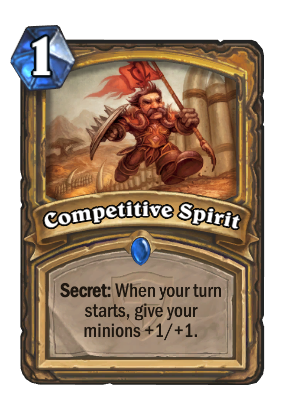
The newest Paladin secret, Competitive Spirit triggers whenever there is a minion it can buff at the beginning of the turn. To minimize the damage from it, then, aim to allow it to trigger on a board with only one minion, preferably something either weak or that you will be removing anyway.
Competitive Spirit punishes you for waiting to trigger Avenge, since you end up leaving a board with multiple minions, all of which get buffed. With two secrets in play or in a case where the secret could be either of the two, you may need to judge whether a buffed board or a single large buffed minion is the greater evil.
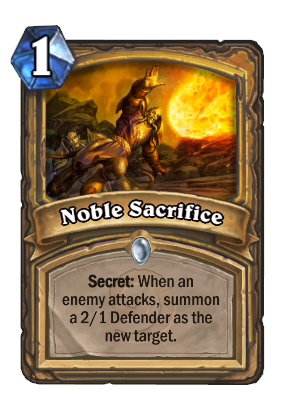
Noble Sacrifice triggers whenever you attack with something. By itself, it is not that scary, but it can affect the game in big ways if it blocks an attack by something big like a Molten Giant, or prevents you from trading to remove an early Knife Juggler. It can also cause Avenge to trigger on a board with only one minion.
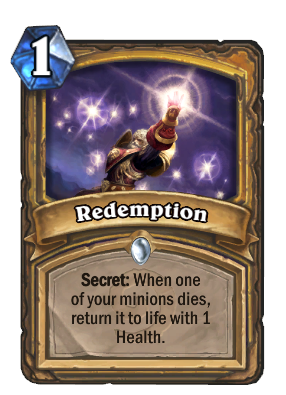
Redemption triggers whenever you kill a minion. To play around it, generally try to kill less threatening minions first. Be prepared to lose some games to turn 1 Redemption, turn 2 Knife Juggler.
In the past, Redemption has mainly been used for its synergy with Divine Shield minions, but it also works together with other Paladin secrets. For example, even if you are able to completely clear the board to play around Avenge, with Redemption in play Avenge will still trigger. It also resummons the minion from Noble Sacrifice. If Redemption is played before Avenge, it is possible for a killed minion to buff itself after being resummoned. I have yet to see this happen when both secrets are put into play by Mysterious Challenger, but according to Blizzard, Mysterious Challenger puts secrets into play in a random order, so it should be possible. EDIT: while this interaction worked in a previous patch, there may have been an unannounced chance that prevents Avenge from buffing the minion from Redemption.
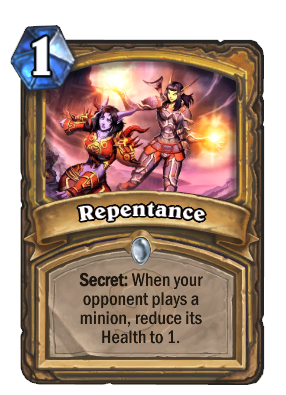
Repentance triggers when you play a minion, and it is the odd one out of Paladin secrets in that it does not directly interact with your sequencing of attacks and removal. It is straightforward to play around, if you are running a deck with some low health minions in it, but some decks with more hefty minions may find it annoying. Ideally, you want to at least avoid triggering Repentance with a taunt, and maybe you can do something clever like play Sylvanas into Repentance.
Generally, Repentance is regarded as less powerful than Avenge, Competitive Spirit, Redemption, and Noble Sacrifice, so in Secrets Paladin lists with only 4 secrets, Repentance will be the one missing.
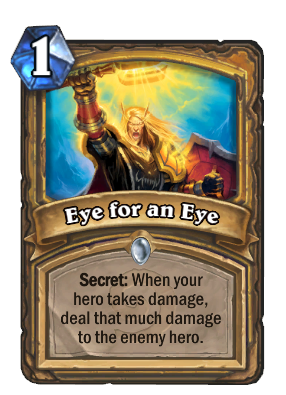
We can safely ignore Eye for an Eye, since nobody plays it (though I live for the day when I can watch somebody steal a tournament game by having it in her deck). For the paranoid, attacking face with the smallest minion first is a good habit, regardless. Even if somebody were to run Eye for an Eye as a 6th secret, Mysterious Challenger is only able to put 5 secrets into play at a time.
Strategy Against Secrets Paladin
The most important thing when dealing with a Secrets Paladin is to keep track of what secrets you have seen so far. Given that many lists run 10 secrets, keeping track, even on a piece of paper if you have to, makes it much easier to predict what you need to play around if your opponent drops 1 or 2 secrets at a time.
Secrets Paladin puts aggressive decks in a difficult spot, since Mysterious Challenger comes down on turn 6, and there is no aggressive deck in the game that can reliably win by turn 5. Noble Sacrifice can slow down an aggressive deck by a few points of damage, but the bigger problem secret is Competitive Spirit, which enables Paladin to easily outrace a face deck that ignores the Paladin’s board. Hunter has a lot of good tools, with Unleash the Hounds, Explosive Trap, and Flare, but other aggressive decks may need to be resourceful.
Kezan Mystic does very little against Secrets Paladin, since the real power of Paladin secrets comes from their synergy with one another. The Mage hero power seems particularly suited to playing against Secrets Paladin, since it can help set up a less threatening board without losing value. Mages also have access to a lot of strong area of effect removal, either in the form of Goblin Blastmage and Flamewaker, or slower board clears like Flamestrike and Frost Nova + Doomsayer.
As the control deck, you should aim to clear the Paladin’s board going into his turn 6, since Mysterious Challenger is almost impossible to beat when it comes down on a well developed board. For most classes, a 6/6 is very difficult to deal with, so it can be helpful to plan on setting up Avenge to buff Mysterious Challenger, then using Big Game Hunter to remove it. Be careful about triggering Redemption, though, unless you can easily remove a 6/1. The more sticky minions are on the Paladin’s board when Mysterious Challenger comes down, the harder it is to trigger Avenge in a way that helps your removal, and the more value the Paladin will get from Competitive Spirit.
There will always be some games where the Secrets Paladin gets an unbeatable draw. Redemption on an early Knife Juggler, followed by drawing both Mysterious Challengers with most of the secrets still in the deck — might be even stronger than a midrange Hunter that curves perfectly into both Savannah Highmanes. Like other decks that rely on a few extremely powerful cards, Secrets Paladin is inconsistent by its nature. When playing against it, try to remember that for every game it steals by drawing well, it will lose another by drawing poorly.
Incidentally, if Secrets Paladin continues to be powerful in the face of an increasingly refined meta, the ability to get unbeatable draws may make it a good tournament deck. Since by definition it requires luck to win a tournament against skilled players, it can be a good strategy to bring decks that reward luck with guaranteed wins. More consistent decks may be good for ladder, but in tournaments, consistency may only get you to consistently lose in the round of 8.
Will Secrets Paladin continue to see play as other decks get refined, and the meta shifts back to standard strategies like Patron Warrior and Zoo? You can find good players to give either opinion. Personally, I suspect that Mysterious Challenger is a good enough card to sustain this deck in competitive play, but once players become used to playing against it, it may sink to tier 2 or 3. That is my hope, at any rate. I’m glad to see Paladin secrets get use, but if a deck turns out to be top tier over an extended period of time, solely on the back of one card’s power, that might be something for Blizzard to look at tweaking.
Shevek streams Sun, Mon, Wed, and Thu evening (Pacific time) at twitch.tv/shevek18.
You can follow him on Twitter @Shevvek. He plays for @RudeHouseGaming.
